New, Modern Yurt Build In Mongolia |
 |
|
 07-30-2022, 03:51 AM
07-30-2022, 03:51 AM
|
#11
|
|
Yurt Forum Addict
Join Date: Jul 2018
Location: Austria
Posts: 244
|
 Re: New, modern yurt build in Mongolia
Re: New, modern yurt build in Mongolia
Thanks again for your qualified answer, @UKadventurer. 
Quote:
Originally Posted by UKadventurer

There is definitely a certain amount of leakage in traditional gers, especially around the chimney. The crown cover can not touch the chimney because, as I found out, it will burn the fabric or melt it. Depending on the type of material. Chimneys here a single wall metal, so they are extremely hot even in the opening.
|
They donīt use other chimneys on different reasons:
At first are the possibilities to buy insulated, high quality chimneys limited and second brings the radiation of an single wall metal chimneys additional ..... 
Thanks too for the excellent and for understanding helpful pics....
Quote:
Originally Posted by UKadventurer

Personally, I prefer the modern design and want to make it as efficient as a house.
|
Me too. 
|

|

|
| Welcome to the Yurt Forum - A Yurt Community About Yurts. |
|
If this is your first visit, be sure to check out the FAQ by clicking the link above.
You may have to register before you can post: click the register link above to proceed.
To start viewing messages, select the forum that you want to visit from the selection below.
|
 07-30-2022, 09:18 AM
07-30-2022, 09:18 AM
|
#12
|
|
Yurt Forum Addict
Join Date: Mar 2022
Location: Ulaanbaatar, Mongolia
Posts: 118
|
 Re: New, modern yurt build in Mongolia
Re: New, modern yurt build in Mongolia
Well, the nomad design of ger/yurt is designed to transported, erected and dismantled in a few hours. Several times per year. The transportation part requires the lowest possible bulk and weight. Low cost too is a factor. I think a traditional ger costs about $1000-2000 new, depending on size, at the Narantuul market in Ulaanbaatar. I've seen some the smaller ones carried in and on a family car. These are the smallest ones with just one felt layer. The traditional one on our land took 2 cars because it's a 5-wall (6.2m diameter) with 2 felt layers.
Therefore, a minimalist stove and chimney fits the pragmatic style of nomads. Family's here love traditions so most of them who aren't nomads anymore still have a family ger on some land. This is their summer home for the holidays only, not a full-time home.
Our stove is a bit fancier. We did buy some double walled, insulated chimney parts, because it sort of made sense. After you've burned yourself (or your canvas) on the chimney, it makes more sense. Those parts are costly for a summer camp ger but for us it's intended as our only home, four seasons.
I'm looking forward to winter, as it will test us to the extreme. I hope we don't chicken out and fly to Vietnam for the winter - our little escape plan. That being said we have multiple backup heat sources (electric, wood, propane and diesel (generator AND heater)).
Since I took early retirement this is a lot of fun for me. The projects could keep me busy for the rest of my life. Or at least until I'm incapable of physical work.
Besides the underfloor electric , I've added some photos of the other methods. Each has its disadvantages and advantages. The diesel has to be exhausted carefully but the fumes can re-enter the ger if the wind is not favourable. My wife complained of the smell immediately.
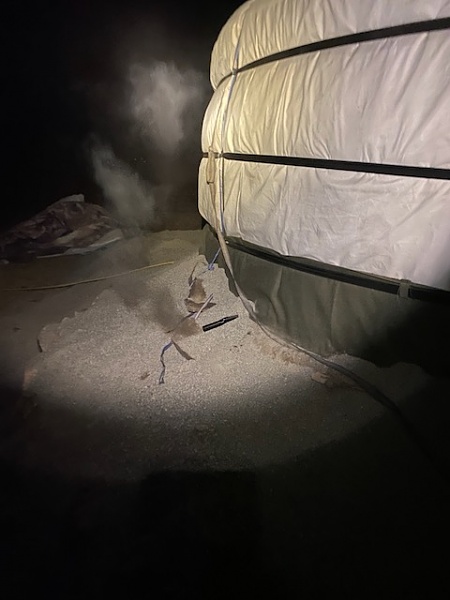
Propane needs lots of fresh air which sort of defeats the object when it's extremely cold outside.
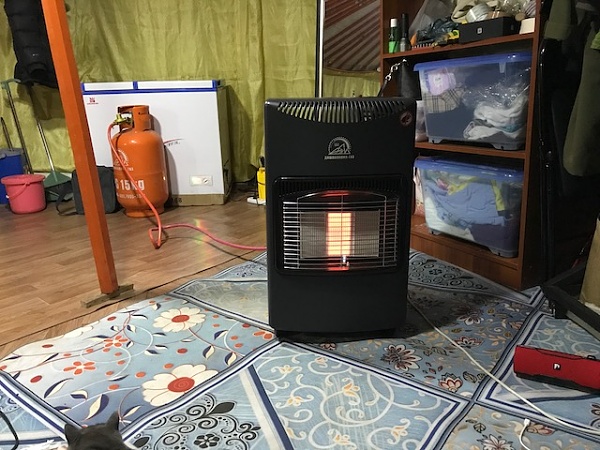
Wood burning requires a lot of attention to keep it fed. We bought two of these, one for each modern ger.
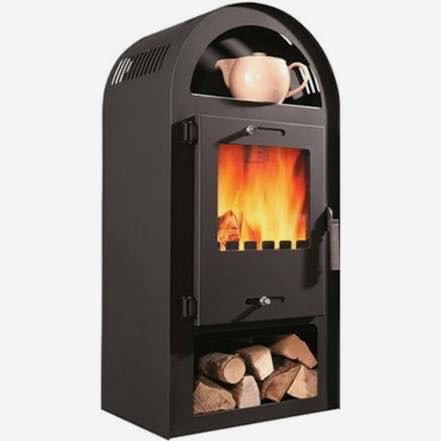
The air quality is normally incredibly good so we'd rather not mess it up. I've got an air quality monitor which shows the lowest setting most days.
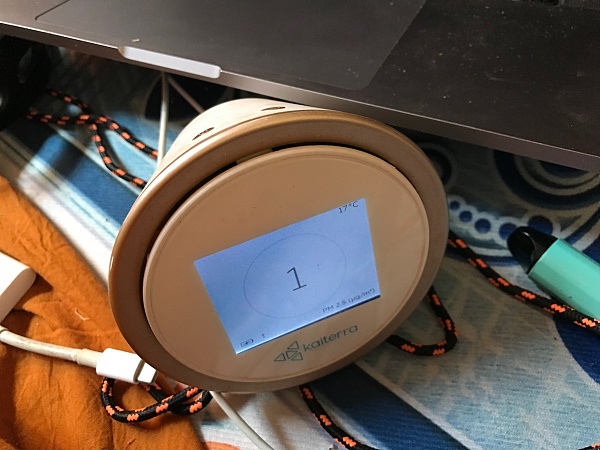
|

|

|
 07-31-2022, 03:53 AM
07-31-2022, 03:53 AM
|
#13
|
|
Yurt Forum Addict
Join Date: Jul 2018
Location: Austria
Posts: 244
|
 Re: New, modern yurt build in Mongolia
Re: New, modern yurt build in Mongolia
Again great stuff and excellent detailed explanation. 
Quote:
Originally Posted by UKadventurer

Since I took early retirement this is a lot of fun for me. The projects could keep me busy for the rest of my life. Or at least until I'm incapable of physical work.
|
You donīt need to do the physical work by yourself till an breakdown - try to become early an good commander and delegate the hard work. 
As long you feel fit you can always give a hand - but the people around should see such action as honor, that youīre working together with them, it should not be the daily standard.... 
|

|

|
 08-06-2022, 02:39 AM
08-06-2022, 02:39 AM
|
#14
|
|
Yurt Forum Addict
Join Date: Mar 2022
Location: Ulaanbaatar, Mongolia
Posts: 118
|
 Re: New, modern yurt build in Mongolia
Re: New, modern yurt build in Mongolia
We added underfloor heating and laminate floor. Total cost was about $1700 installed for 2 x 7m diameter gers. We paid professionals to do it. Iím not comfortable making this my first such project. Iíve installed hardwood floors in rectangular houses but never a circular one. Just to refresh your memory, our foundation is concrete with expanded clay .
Step 1 was unrolling 8mm thick Mylar backed foam. This reflects heat upwards and accommodates small surface variations in the concrete.
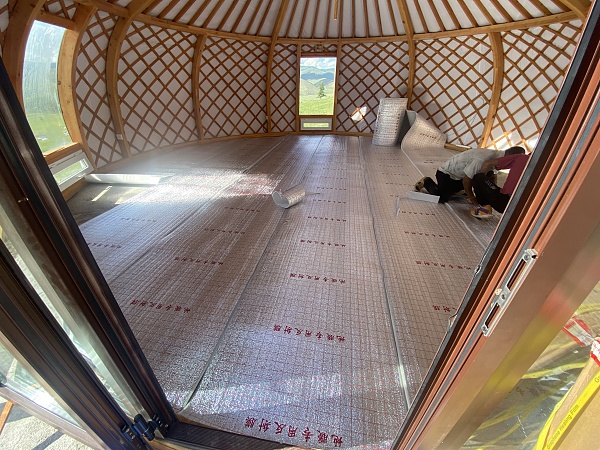
Step 2 is unrolling and connecting the underfloor mats. They are from a Korean company. They donít cover the entire floor because you canít cut them crosswise. Of the 40m/2 of each floor, about 27m/2 is heated. In 2 zones for some reason. We have 240v so each zone has a 16 amp circuit breaker.
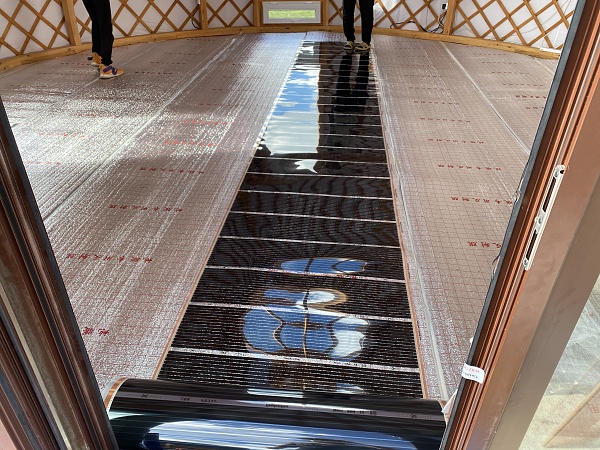
Finally, the laminate floor is installed. Thereís tons of accurate cuts required. Not shown is the very final step of using the same wood used for the lattice walls as a trim edge to hide the gaps. Between floor and bottom ring. We chose a contrasting tone of floor in the widest planks available for fewer seams and cuts. The plank dimensions are 1.2m x 0.8m x 1.2cm thick.
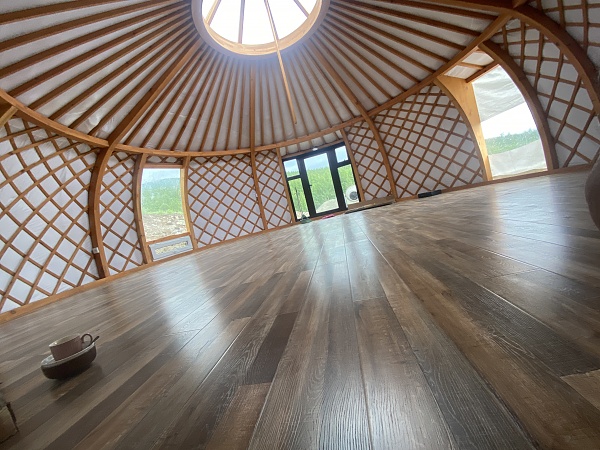
|

|

|
 08-06-2022, 08:00 AM
08-06-2022, 08:00 AM
|
#15
|
|
Yurt Forum Addict
Join Date: Jul 2018
Location: Austria
Posts: 244
|
 Re: New, modern yurt build in Mongolia
Re: New, modern yurt build in Mongolia
Quote:
Originally Posted by UKadventurer

Finally, the laminate floor is installed.
|
What was the reason for the laminate floor, and not laying an parquet flooring (like bamboo e.g.)?
BTW - it looks cool and really professional.... 
|

|

|
 08-07-2022, 08:22 AM
08-07-2022, 08:22 AM
|
#16
|
|
Yurt Forum Addict
Join Date: Mar 2022
Location: Ulaanbaatar, Mongolia
Posts: 118
|
 Re: New, modern yurt build in Mongolia
Re: New, modern yurt build in Mongolia
Quote:
Originally Posted by TSRalex

What was the reason for the laminate floor, and not laying an parquet flooring (like bamboo e.g.)?
BTW - it looks cool and really professional....  |
Thanks, we like it a lot.
Choices in Mongolia are very, very limited. You can import flooring - usually from China - but it's slow and costly. So I went with what was available locally and in stock in the largest plank size. There were only 3 choices of pattern. That's what I mean by limited.
Laminate planks are cheap, quick to install and look good enough.
When I lived in the USA, I had bamboo and African hardwood floors which I installed myself. They look great but aren't available in stock here. Also, if I remember correctly, they were much more costly. My budget is much lower now. If money and time was not a factor, I would've chosen bamboo floors.
|

|

|
 08-07-2022, 09:06 AM
08-07-2022, 09:06 AM
|
#17
|
|
Yurt Forum Addict
Join Date: Jul 2018
Location: Austria
Posts: 244
|
 Re: New, modern yurt build in Mongolia
Re: New, modern yurt build in Mongolia
Quote:
Originally Posted by UKadventurer

If money and time was not a factor, I would've chosen bamboo floors.
|
Me too. 
Quote:
Originally Posted by UKadventurer

Choices in Mongolia are very, very limited. You can import flooring - usually from China - but it's slow and costly.
|
Slow & costly? I have an German friend and he is located in Novosibirsk, which is approx. 1000 km far away from the North-Western-Border of Mongolia - plus additional 1600 km from Ulaanbaatar, and he bought bamboo floor from China, with an excellent price (as half of the costs in EU) and it was delivered within 2 weeks....
|

|

|
 08-07-2022, 11:19 AM
08-07-2022, 11:19 AM
|
#18
|
|
Yurt Forum Addict
Join Date: Mar 2022
Location: Ulaanbaatar, Mongolia
Posts: 118
|
 Re: New, modern yurt build in Mongolia
Re: New, modern yurt build in Mongolia
Quote:
Originally Posted by TSRalex

Me too. 
Slow & costly? I have an German friend and he is located in Novosibirsk, which is approx. 1000 km far away from the North-Western-Border of Mongolia - plus additional 1600 km from Ulaanbaatar, and he bought bamboo floor from China, with an excellent price (as half of the costs in EU) and it was delivered within 2 weeks.... |
When was that? Unfortunately Inner Mongolia has been closed several times due to China's zero Covid policy. This stops all ground freight and goods to Mongolia. It happened last year and it's happened again recently. I ordered an electric mountain bike from China. It was stuck in a warehouse at the border for 3 months. Only air freight is coming in and slower than usual due to less flights. Even air freight items such as my 4g booster antenna took 3 weeks. Mostly waiting for a flight from Incheon, Korea to Ulaanbaatar.
I'm not sure about the cost of bamboo. A quick search at alibaba.com shows about US$18 per square meter (plus shipping). My laminate floor was US$9 delivered. You usually have to buy large quantities with alibaba. Also, we were in a hurry and winter is coming. Nights are already getting cold and we needed the underfloor heating up and running quickly. So there was that factor too. We can now heat our gers and we are already using it!
Next step, of many, is to install the wood stoves we've had stored in our shipping containers for a few weeks. I love a wood burning fire and the wood is free.
|

|

|
 08-07-2022, 11:39 AM
08-07-2022, 11:39 AM
|
#19
|
|
Yurt Forum Addict
Join Date: Jul 2018
Location: Austria
Posts: 244
|
 Re: New, modern yurt build in Mongolia
Re: New, modern yurt build in Mongolia
Quote:
Originally Posted by UKadventurer

When was that? Unfortunately Inner Mongolia has been closed several times due to China's zero Covid policy. This stops all ground freight and goods to Mongolia.
.....
My laminate floor was US$9 delivered.
....
Alibaba
.....
|
He bought FCL (40") - for US$11/m≤ - which was pretty much stuff for him, but he sold the unneeded floor for an reasonable, but although profitable price.
Delivery was last march by truck.
He bought not via Alibaba - he has had an direct supplier as far as I know...
|

|

|
 08-09-2022, 03:59 AM
08-09-2022, 03:59 AM
|
#20
|
|
Yurt Forum Addict
Join Date: Mar 2022
Location: Ulaanbaatar, Mongolia
Posts: 118
|
 Re: New, modern yurt build in Mongolia
Re: New, modern yurt build in Mongolia
Quote:
Originally Posted by TSRalex

He bought FCL (40") - for US$11/m≤ - which was pretty much stuff for him, but he sold the unneeded floor for an reasonable, but although profitable price.
Delivery was last march by truck.
He bought not via Alibaba - he has had an direct supplier as far as I know...
|
Itís a decent price but shipping is impossible at the moment.
|

|

|
 |
|
 Posting Rules
Posting Rules
|
You may not post new threads
You may not post replies
You may not post attachments
You may not edit your posts
HTML code is Off
|
|
|
|
|

